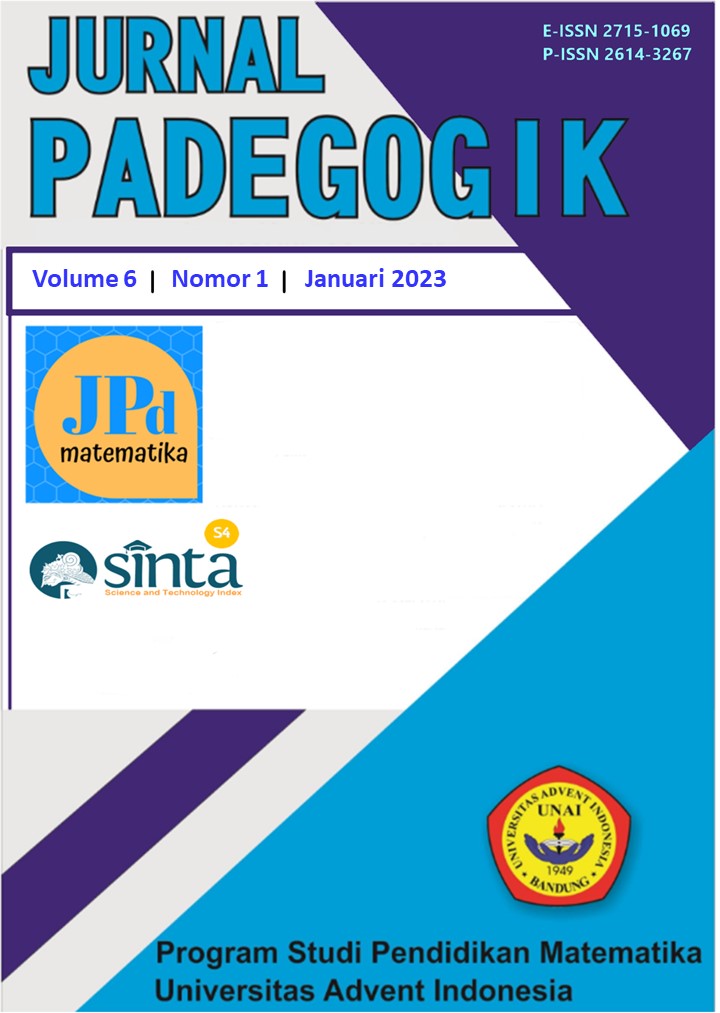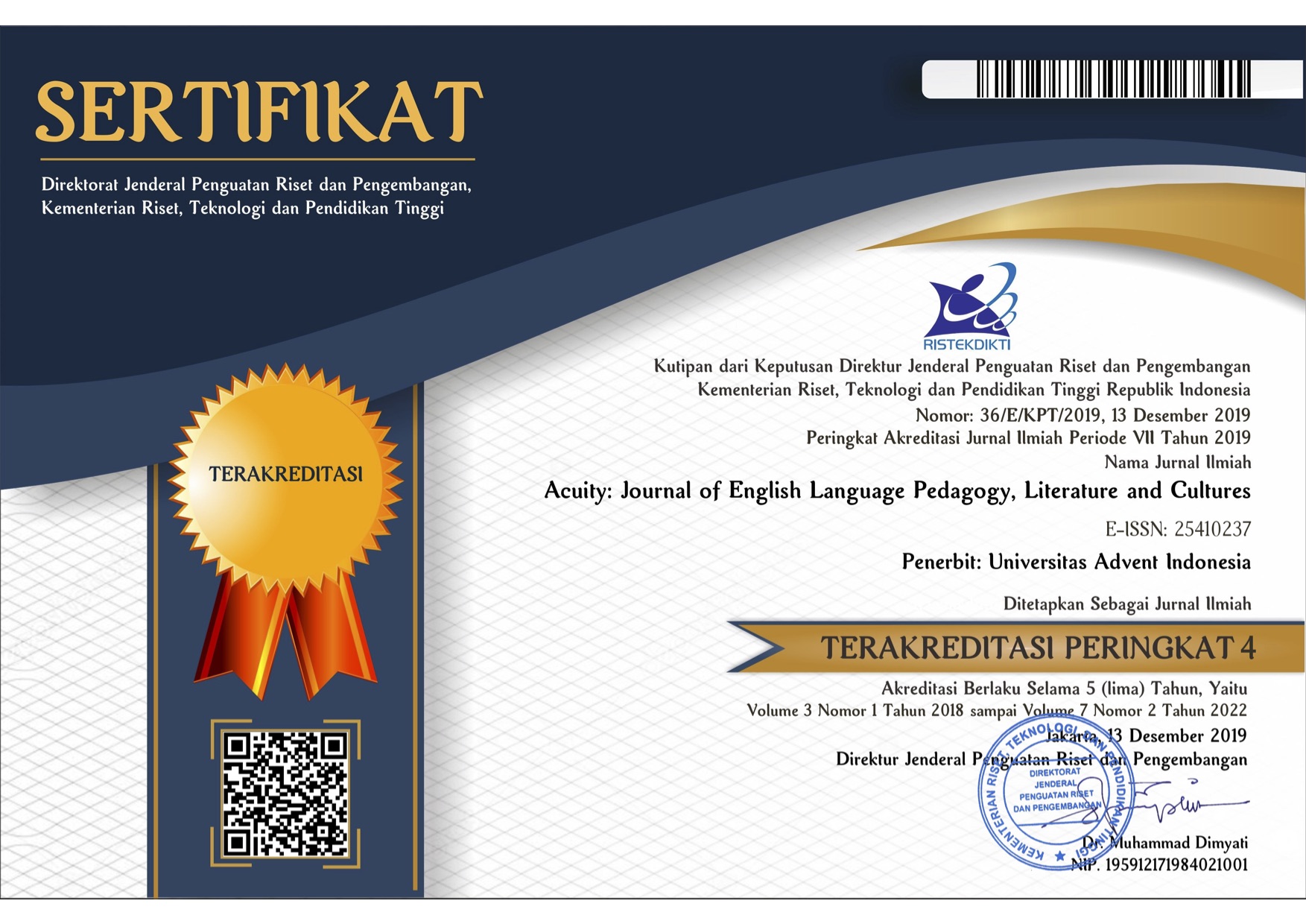Ethnomatematics Exploration in the Manuk Dadali Dance Movement on Geometry Concepts
Keywords:
Ethnomatematics, Geometry Concepts, The Manuk Dadali Dance, Traditional DanceAbstract
Mathematics is a subject that has several main topics such as shapes and sizes with their own difficulties so that they need to be studied in a way that is closer to everyday life. One way that can be done is to link mathematics with culture, for example, is traditional dance. Manuk Dadali is a traditional dance from West Java that can be used as learning material for students through ethnomathematics-based learning. This research is an exploratory research conducted to analyze and discuss the geometric concepts contained in the Manuk Dadali Dance using an ethnographic approach. The data is collected by observation, documentation and interviews. Based on the research conducted, it was found that geometric elements in Manuk Dadali dance movements and floor patterns, including angular geometry, two-dimensional geometry, and transformation geometry.
Downloads
References
Amsikan, S., & Nahak, S. (2017). HUBUNGAN KONSEP RUANG UME KBUBU DESA KAENBAUN KABUPATEN TIMOR TENGAH UTARA DENGAN KONSEP GEOMETRI. Publikasi Ilmiah UMS, 168–175. http://hdl.handle.net/11617/8763
Darwati, A., Yusuf Muslihin, H., & Giyartini, R. (2019). KEGIATAN TARI KREASI MANUK DADALI UNTUK MENINGKATKAN KECERDASAN KINESTETIK ANAK KELOMPOK B DI TK ARTANITA AL-KHAIRIYAH KOTA TASIKMALAYA. Jurnal PAUD Agapedia, 3(2), 164–177. https://doi.org/10.17509/jpa.v3i2.26679
Destrianti, S., Rahmadani, S., Ariyanto, T., Tarbiyah, F., Tadris, D., & Curup, I. (2019). Etnomatematika dalam Seni Tari Kejei Sebagai Kebudayaan Rejang Lebong. Jurnal Equation, 2(2), 116–132. http://dx.doi.org/10.29300/equation.v2i2.2316
Dewi, L. I. P., Hartawan, I. G. N. Y., & Sukajaya, I. N. (2019). ETNOMATEMATIKA DALAM TARI BALI DITINJAU DARI KLASIFIKASI TARI BALI. Jurnal Pendidikan Dan Pembelajaran Matematika Indonesia, 8(1). https://doi.org/10.23887/jppm.v8i1.2842
Fadlilah, U., Trapsilasiwi, D., & Oktavianingtyas, E. (2015). IDENTIFIKASI AKTIVITAS ETNOMATEMATIKA PETANI PADI PADA MASYARAKAT JAWA DI DESA SETAIL. KadikmA, 6(3), 45–56. https://doi.org/10.19184/kdma.v6i3.5163
Fauzi, I., & Arisetyawan, A. (2020). Analisis Kesulitan Belajar Siswa pada Materi Geometri Di Sekolah Dasar. Kreano, Jurnal Matematika Kreatif-Inovatif, 11(1), 27–35. https://doi.org/10.15294/kreano.v11i1.20726
Lestari, I. (2013). Pengaruh Waktu Belajar dan Minat Belajar Terhadap Hasil Belajar Matematika. Jurnal Formatif, 3(2), 116. http://dx.doi.org/10.30998/formatif.v3i2.118
Loviana, S., Merliza, P., Damayanti, A., Mahfud, M. K., & Islamuddin, A. M. (2020). Etnomatematika pada Kain Tapis dan Rumah Adat Lampung. Tapis : Jurnal Penelitian Ilmiah, 4(1), 94. https://doi.org/10.32332/tapis.v4i1.1956
Mukarromah, N. A., & Darmawan, P. (2022). ETNOMATEMATIKA PADA POLA LANTAI TARI GANDRUNG BANYUWANGI.
Nahak, H. M. I. (2019). UPAYA MELESTARIKAN BUDAYA INDONESIA DI ERA GLOBALISASI. Jurnal Sosiologi Nusantara, 5(1), 65–76. https://doi.org/10.33369/jsn.5.1.65-76
Naja, F. Y., Mei, A., & Sa’o, S. (2021). EKSPLORASI KONSEP ETNOMATEMATIKA PADA GERAK TARI TRADISIONAL SUKU LIO. AKSIOMA: Jurnal Program Studi Pendidikan Matematika, 10(3), 1836. https://doi.org/10.24127/ajpm.v10i3.3885
Nurina, A. D., & Indrawati, D. (2021). EKSPLORASI ETNOMATEMATIKA PADA TARI TOPENG MALANGAN SEBAGAI SUMBER BELAJAR MATEMATIKA SEKOLAH DASAR. JPGSD, 9(8), 3114–3123.
Prahmana, R. C. I., & Istiandaru, A. (2021). Learning sets theory using shadow puppet: A study of javanese ethnomathematics. Mathematics, 9(22). https://doi.org/10.3390/math9222938
Rahayu, E. (2021). PROBLEMA KESULITAN SISWA SEKOLAH DASAR DALAM PEMBELAJARAN GEOMETRI. AtTàlim : Jurnal Pendidikan, 7(1), 2548–4419. https://doi.org/10.36835/attalim
Rahmani, P. A. E., Susanto, Monalisa, L. A., Hobri, & Murtikusuma, R. P. (2018). EKSPLORASI ETNOMATEMATIKA RITUAL SEBLANG OLEHSARI TERHADAP KONSEP GEOMETRI. Kadikma, 9(2), 108–117. http://repository.unej.ac.id/handle/123456789/90421
Sa’adah, N., Haqiqi, A. K., & Malasari, P. N. (2021). ETNOMATEMATIKA GERAKAN TARI KRETEK KUDUS PADA PEMBELAJARAN MATEMATIKA. ALGORITMA Journal of Mathematics Education, 3(1), 58–71. https://doi.org/10.15408/ajme.v3i1.20544
Sandhi, N. S. A., Trapsilasiwi, D., & Yudianto, E. (2018). ETNOMATEMATIKA POLA TARIAN JEJER JARAN DAWUK BANYUWANGI SEBAGAI INSPIRASI PENGEMBANGAN PAKET TES GEOMETRI. KadikmA, 9(3), 160–170. https://doi.org/10.19184/kdma.v9i3.11280
Suyitno, I. (2012). PENGEMBANGAN PENDIDIKAN KARAKTER DAN BUDAYA BANGSA BERWAWASAN KEARIFAN LOKAL. Jurnal Pendidikan Karakter, 3(1). https://doi.org/10.21831/jpk.v0i1.1307
Triasih, S. (2019). PENGEMBANGAN BAHAN AJAR BERBASIS ETNOMATEMATIKA PADA TARI SIGEH PENGUTEN DALAM MEMAHAMI KONSEP.
Wulandari, I. G. A. P. A., Kadek, D., & Puspadewi, R. (2016). BUDAYA DAN IMPLIKASINYA TERHADAP PEMBELAJARAN MATEMATIKA YANG KREATIF. Jurnal Santiaji Pendidikan, 6(1), 31–37.
Zaenuri, N. D. (2018). Menggali Etnomatematika: Matematika sebagai Produk Budaya Zaenuri, Nurkaromah Dwidayati. Prisma, Prosiding Seminar Nasional Matematika, 1, 471–476. https://journal.unnes.ac.id/sju/index.php/prisma/article/view/20136
Zulianti, F. E., Hidayat, T., & Meifiani, N. I. (2021). EKSPLORASI ETNOMATEMATIKA TARI SEKAR KLAYAR. http://repository.stkippacitan.ac.id

Downloads
Published
How to Cite
Issue
Section
License
Copyright (c) 2023 Jurnal Padegogik

This work is licensed under a Creative Commons Attribution-NonCommercial-ShareAlike 4.0 International License.
The submitting author warrants that
- The submission is original and that she/he is the author of the submission together with the named co-authors; to the extend the submission incorporates text passages, figures, data, or other material from the work of others, the submitting author has obtained any necessary permission.
- Articles in this journal are published under the Creative Commons Share-Alike Attribution Licence (CC-BY-SA What does this mean?). This is to get more legal certainty about what readers can do with published articles, and thus a wider dissemination and archiving, which in turn makes publishing with this journal more valuable for you, the authors.
- By submitting an article the author grants to this journal the non-exclusive right to publish it. The author retains the copyright and the publishing rights for his article without any restrictions.







